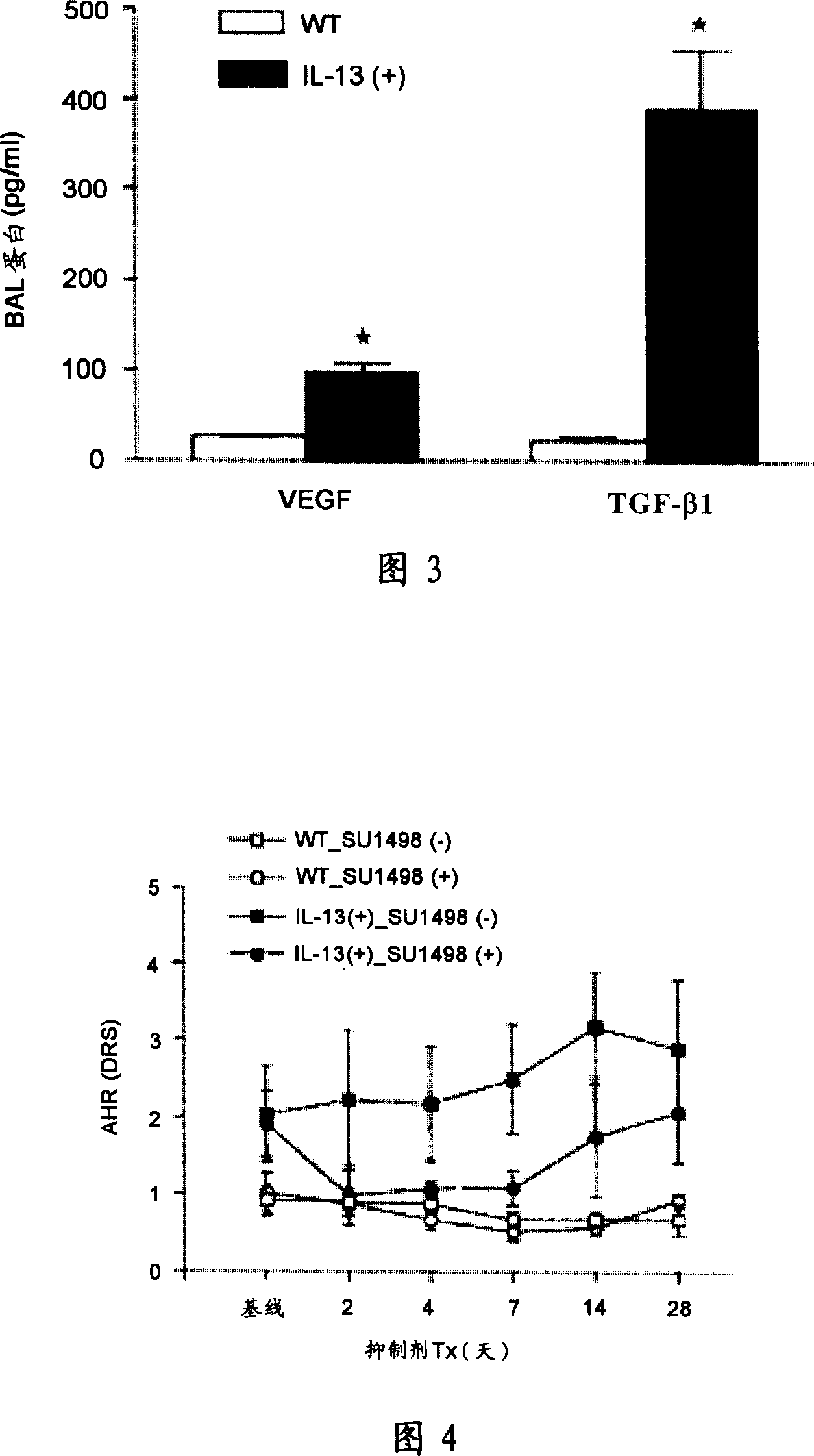An agent comprising fgf2 as an effective ingredient for treatment or prevention of asthma and chronic obstructive pulmonary disease
A chronic obstructive, active ingredient technology, applied in the prevention and treatment of asthma and chronic obstructive pulmonary disease agents, COPD and Th1 asthma mouse models, can solve the problems of pathogenesis limitation, COPD pathogenesis has not been elucidated, etc.
- Summary
- Abstract
- Description
- Claims
- Application Information
AI Technical Summary
Problems solved by technology
Method used
Image
Examples
Embodiment 1
[0127] Example 1 Asthma induced by IL-13 overexpression and the correlation between TGF-β1 and VEGF
[0128] In order to study the pathogenesis of IL-13-induced asthma, IL-13 transgenic mice were prepared, and the AHR of each mouse was measured. The effect of IL-13 overexpression on the expression of TGF-β1 and VEGF was also investigated.
[0129] 1-1 Preparation of IL-13 transgenic mice
[0130] By conventional methods (Zhou Zhu et al., J.Clin.Invest., 103:779-788, 1999; Tang et al., J.Clin.Invest., 98:2845-2853, 1996; Ray et al., J.Clin. Invest., 100:2501-2511, 1997) to generate IL-13 transgenic mice. To enable selective expression of IL-13 candidate genes in the airways, constructs containing IL-13 candidate genes were linked to promoters (B. Stripp and J. Whitsett, University of Cincinnati), using the inducible 10kDa Clara cell protein (CC10 ) expression promoter. To generate inducible transgenic mice in which expression of the embedded gene can be regulated from th...
Embodiment 2
[0140] Example 2 The role of FGF2 in the pathogenesis of IL-13-induced asthma
[0141] To investigate the role of FGF2 in the pathogenesis of IL-13-induced asthma and the role of downstream regulators TGF-β1 and VEGF, AHR and airway remodeling in FGF2 knockout (- / -) mice were observed.
[0142] 2-1 AHR induced by FGF2 deficiency
[0143]The following experiments were performed to investigate the link between FGF2 and AHR. FGF2 knockout mice were purchased from Jackson Lab (CA, USA). Using similar procedures as described in Examples 1-2 and Examples 1-3, the AHR (DRS) to methacholine and the concentrations of VEGF and TGF-β1 in BAL were studied, demonstrating that AHR and VEGF and TGF-β1 concentration increased (Figure 5 and Figure 6). Fig. 5 is a graph showing the expression levels of VEGF and TGF-β1 obtained from FGF2 knockout mice and wild-type controls in BAL. Figure 6 is a graph showing FGF2 knockout mice treated with VEGF blockers as described in Examples 1-4 and ...
Embodiment 3
[0152] The development of asthma caused by embodiment 3TGF-β1
[0153] In order to study the pathogenesis of asthma mediated by IL-13-induced TGF-β1 expression, TGF-β1 transgenic mice were prepared using a procedure similar to that described in Example 1-1, and the following experiments were performed.
[0154] 3-1 Airway remodeling induced by TGF-β1
[0155] AHR resulting from airway remodeling was studied using a procedure similar to that described in Examples 1-2 above (Fig. 7). Figure 7 is a graph showing the comparison of AHR over time between TGF-β1 transgenic mice and wild type controls. Figure 8 is a graph showing a comparison of AHR versus methacholine over time between TGF-β1 transgenic mice and wild type controls.
[0156] As shown in Figure 7, TGF-β1 induced severe airway resistance, a conclusion supported by Penh's results. However, as shown in Figure 8, AHR was inhibited by methacholine. This result suggests that overexpression of TGF-β1 is only involved ...
PUM
 Login to View More
Login to View More Abstract
Description
Claims
Application Information
 Login to View More
Login to View More - Generate Ideas
- Intellectual Property
- Life Sciences
- Materials
- Tech Scout
- Unparalleled Data Quality
- Higher Quality Content
- 60% Fewer Hallucinations
Browse by: Latest US Patents, China's latest patents, Technical Efficacy Thesaurus, Application Domain, Technology Topic, Popular Technical Reports.
© 2025 PatSnap. All rights reserved.Legal|Privacy policy|Modern Slavery Act Transparency Statement|Sitemap|About US| Contact US: help@patsnap.com



